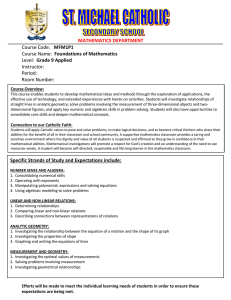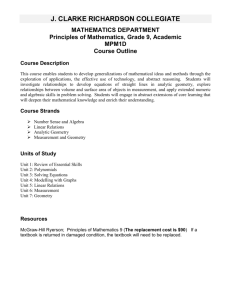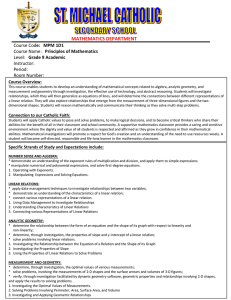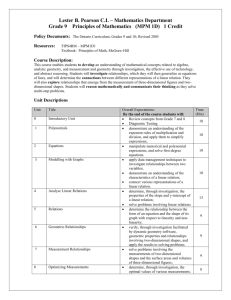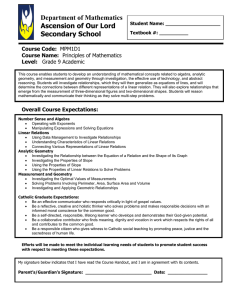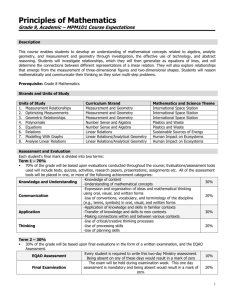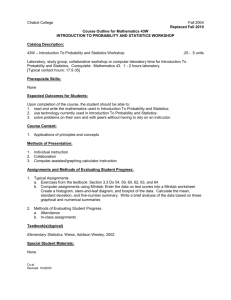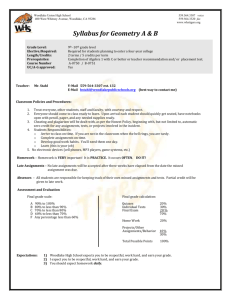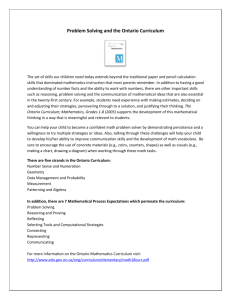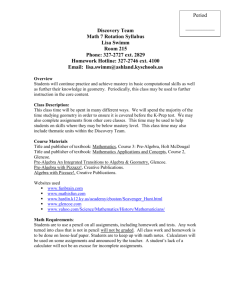Grade 9 Math Syllabus: Algebra, Geometry, & Linear Relations
advertisement
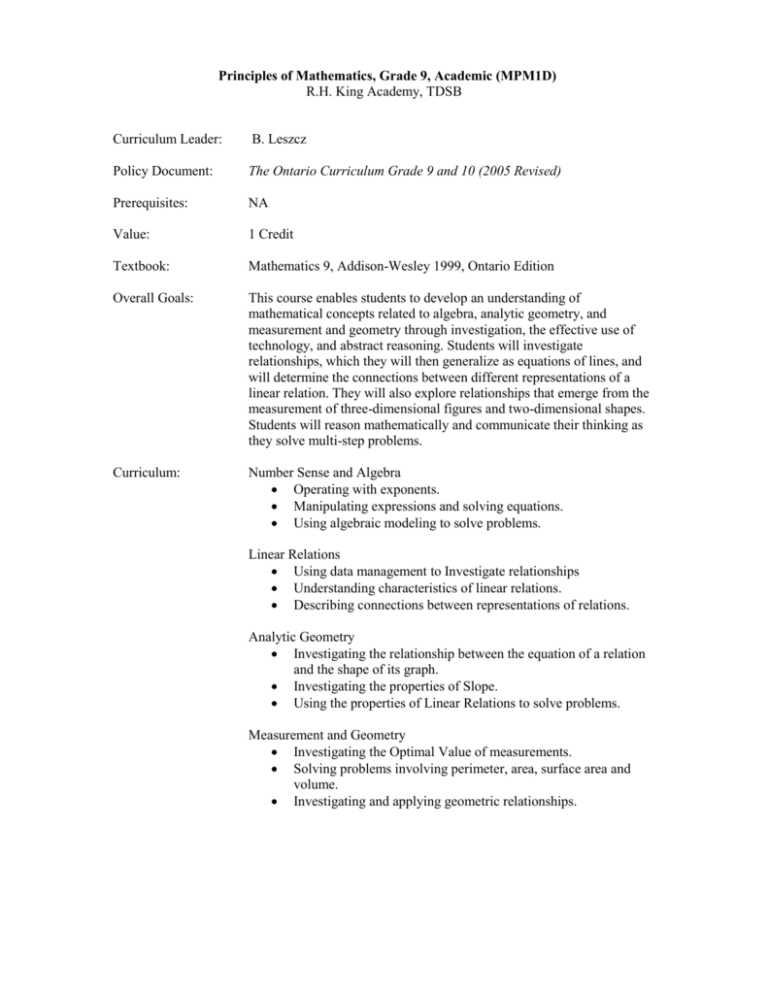
Principles of Mathematics, Grade 9, Academic (MPM1D) R.H. King Academy, TDSB Curriculum Leader: B. Leszcz Policy Document: The Ontario Curriculum Grade 9 and 10 (2005 Revised) Prerequisites: NA Value: 1 Credit Textbook: Mathematics 9, Addison-Wesley 1999, Ontario Edition Overall Goals: This course enables students to develop an understanding of mathematical concepts related to algebra, analytic geometry, and measurement and geometry through investigation, the effective use of technology, and abstract reasoning. Students will investigate relationships, which they will then generalize as equations of lines, and will determine the connections between different representations of a linear relation. They will also explore relationships that emerge from the measurement of three-dimensional figures and two-dimensional shapes. Students will reason mathematically and communicate their thinking as they solve multi-step problems. Curriculum: Number Sense and Algebra Operating with exponents. Manipulating expressions and solving equations. Using algebraic modeling to solve problems. Linear Relations Using data management to Investigate relationships Understanding characteristics of linear relations. Describing connections between representations of relations. Analytic Geometry Investigating the relationship between the equation of a relation and the shape of its graph. Investigating the properties of Slope. Using the properties of Linear Relations to solve problems. Measurement and Geometry Investigating the Optimal Value of measurements. Solving problems involving perimeter, area, surface area and volume. Investigating and applying geometric relationships. Learning Skills: The learning skills (Responsibility, Organization, Independent Work, Collaboration, Initiative, and Self Regulation) are critical for the achievement of the curriculum expectations and student success. Students are expected to attend every class, complete all homework and insure that assignments are completed and handed in on time. Strategies: Students will have the opportunity to learn in a variety of ways – individually, cooperatively, independently, with teacher direction, through hands-on experience, and through examples followed by practice. The approaches and strategies used in the classroom to help students meet the expectations of this curriculum will vary according to the objectives of the learning and the needs of the students. It is important for students to take every opportunity to learn the material covered prior to the evaluation. Students will not use calculators for the first half of the course, to ensure mastery of basic numeracy skills. Technology will be interwoven in the latter half of the course. Evaluation: Seventy per cent of the grade will be based on evaluation conducted throughout the course. Evaluations will be in the form of tests, quizzes, and assignments. Assignments for evaluation may include rich performance tasks, demonstrations (board work), and projects. This portion of the grade will reflect the student’s most consistent level of achievement throughout the course. Thirty per cent of the grade will be based on a final assessments administered towards the end of the course. The final evaluations allows the student an opportunity to demonstrate comprehensive achievement of the overall expectations for the course. It will be comprised of a grade wide test, assignment, and the EQAO-the Government of Ontario sponsored mathematics exam for all students in the province. Preparation for the EQAO will be done on an ongoing basis. Parts of the EQAO will be marked by the classroom teacher and contribute to the summative assessment weighting. Students will be given numerous and varied opportunities to demonstrate the full extent of their achievement of the curriculum expectations (content standards) across all four categories of knowledge and skills. Teachers will ensure that student learning is assessed and evaluated in a balanced manner with respect to these four categories: 1. Knowledge and Understanding Subject specific content acquired in each course, and the comprehension of its meaning and significance. 2. Thinking The use of critical and creative thinking skills and/or processes. 3. Communication The conveying of meaning through various forms. 4. Application The use of knowledge and skills to make connections within and between various contexts. Term Grades for Provincial Reports throughout the Year: The midterm mark will be based on the evaluations that have been conducted to that point in the course and will be preliminary and tentative. This mark will be based on the most consistent level of achievement to that point in time, but some of the overall expectations, strands, and units will not have been addressed and the student’s grades will most likely change when the student’s entire work is evaluated by the end of the course. Evaluation Plan Principles of Mathematics, Grade 9, Academic (MPM1D) Term Work- 70% Quizzes, assignments, projects 15% Tests 45% Independent Study Assignments* 10% Final Evaluation – 30% Test – 10% Assignment 5% EQAO – 15% *Students will receive 4-6 small assignments, on different topics, which they are to complete independently, outside of the classroom. Course Work Grade 9 Mathematics is a non semestered course at King. Students meet with their teacher every other day, from September to June. (3hours instruction 1 week) Unit 1: Numeracy Unit 2: Powers and Roots – Ch. 3 Unit 3: Algebraic Operations and Polynomials – Ch. 6 Unit 4: Solving Equations, Algebraic Modeling-Ch 7 Unit 5: Relationships– Ch. 4/5 Unit 6: Analytic Geometry –Ch. 8 Unit 7: Measurement and Geometry –Ch.9/10 Review and Preparation for Evaluations: (24 hours-8 weeks) (10 hours-3 weeks) (10 hours-3 weeks) (10 hours-3 weeks) (10 hours-3 weeks) (24 hours-8 weeks) (10 hours-3 weeks) (3 hours-1 week)
